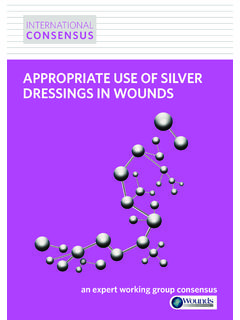Transcription of GAMMA PROCESSING TECHNOLOGY: AN …
1 GAMMA PROCESSING technology : an alternative technology FOR. TERMINAL STERILIZATION OF PARENTERALS. BRIAN D. REID. ABSTRACT:' This paper will outline the advantages of utilizing GAMMA radiation as a means for terminally sterilizing parenterals and other pharmaceutical products. The factors which must be evaluated in order to qualify a product for radiation sterilization will be detailed. It will also compare the characteristics of this method with other technologies currently available. The highest SAL can be achieved by combining a knowledge of the microbial quality of the raw materials, and the manufacturing environment with a formulation designed to promote the most radiation stable from of the product. Introduction This paper presents an overview of GAMMA Radiation PROCESSING for terminal sterilization as applicable to pharmaceutical products. It focuses on the unique capabilities of GAMMA radiation and how they may best be applied to pharmaceutical products.
2 There is a growing need by, and pressure on, the pharmaceutical industry to find and use alternative terminal sterilization technologies. Each technology has its own particular capabilities. It is the manufacturer's responsibility to select the most appropriate technology for the task. In this context, , the use of "new" technologies, GAMMA Radiation PROCESSING is being more actively investigated now than at any other time. This renewed interest has come at a most appropriate time because the increased use of radiation PROCESSING to sterilize medical devices has led to the development of more efficient and economical irradiation equipment and processes. It has also generated new scientific data. The positive experience of the medical device industry should be a "signpost" for the pharmaceutical industry. Many pharmaceutical raw materials and finished products are currently being successfully sanitized and terminally sterilized using GAMMA radiation.
3 However, other raw materials and finished products have not been successfully treated. The primary reason for this is a lack of knowledge; knowledge of how an irradiation facility operates, and of the effects of GAMMA radiation on many products. Once these topics are more fully understood by the pharmaceutical industry, many more raw materials and finished products will be found compatible with GAMMA irradiation. The reader is directed to the following references for a comprehensive overview: G. Jacobs (1); B. Gordon et al (2). In addition, "Radiation PROCESSING technology for Pharmaceuticals and Cosmetics: A Bibliography" (3) contains some 400-plus references to the effects of irradiation on pharmaceuticals, excipients, containers and closures. A copy of the bibliography and any referenced papers can be obtained from the author. What Is GAMMA Radiation PROCESSING ? GAMMA radiation PROCESSING is defined as the exposure of a product to ionizing radiation in a controlled manner.
4 This controlled exposure ensures that the specified dose of radiation is delivered to the product. The specified dose is that which will reduce the bioburden to the desired level while at the same time minimizing the effect on the product. By controlling the time spent in the irradiation chamber we control the exposure of the product. GAMMA radiation's unique capabilities are used to provide consistently performing raw materials and finished products. How they may best be applied to pharmaceutical raw materials and finished products is the subject of this presentation. Why Use GAMMA Radiation? Penetration The ability of GAMMA radiation to penetrate any existing packaging material permits the selection of the most appropriate packaging to protect the raw material or product. There is a very large selection of radiation resistant packaging materials on the market today. Product Formulation/Packaging Novel forms of packaging such as dual chamber syringes or vials may be used.
5 New drug delivery systems such as liposomes or monoclonal antibodies, can also be successfully irradiated. Because there is no need to consider the diffusion of a gas into or out of the product, multiple packaging layers can be employed. Ease of Validation GAMMA radiation PROCESSING with its single variable, time, makes validation very easy. Time is the only variable as Co(XJ (Cobalt 60) decays at a fixed rate. Once the total number of curies installed and the required dose is known, only the timers, which control the dwell time of the carrier/tote at each position around the source rack, need to be set. This is in direct contrast to gas and steam sterilization where a vacuum system, gas/ steam mixture and the uniformity of heat/ gas within the treatment chamber must be monitored. Similarly, for electron beam, the power variables ( , voltage, current) and the rate of movement of the transport system must be strictly controlled and monitored throughout the irradiation process.)
6 No Post Treatment Quarantine The dosimetry system used means results are available within minutes after treatment. As this indicates the dose delivered to the product, there is no need for sterility testing. There are also no 'residuals' with GAMMA radiation PROCESSING . The product can be shipped directly to the customer. Gaseous treatment methods frequently require a lengthy post-exposure time to remove residual gas. Byproducts of the reaction of the gas are left behind. These byproducts at worst can be toxic (4), and can sometimes cause sensitivity reactions in patients. These residues have been detected for up to 7 days (5), and sometimes even longer. Reduction in Endotoxin Level Two papers have recently been published demonstrating the ability of GAMMA radiation to reduce endotoxins (6, 7). This is a unique feature associated with GAMMA radiation, and does not occur with electron beam irradiation or steam or gas sterilization, which should further encourage the use of GAMMA radiation PROCESSING .
7 How To Use GAMMA Radiation PROCESSING A successful GAMMA radiation PROCESSING program encompasses three basic elements. They are Product Qualification, Equipment Qualification and Process Qualification. All three combined form an integral part of the Process Validation Document. Product Qualification A product qualification program demonstrates the effects of ionizing irradiation on the product. The most important outcome of product qualification is the determination of the product's Maximum Tolerated Dose. In addition, the Maximum Process Dose and the Minimum Process Dose will also be set. The Maximum Tolerated Dose is that dose of radiation which is just below that which induces an unacceptable change in the analytical profile of the pharmaceutical. It may be possible to select a radiation dose at which no radiation-induced changes in the analytical profile can be detected.
8 It is important in the initial product qualification steps to test the product using widely separated radiation doses. This will quickly assess the ability of the product to withstand radiation and to "zero-in" on the most appropriate radiation dose for further testing. One of the doses chosen should be approximately three times the "expected" dose. This will help to identify the type and nature of the breakdown products to expect at lower doses. Thus, analytical techniques can be adjusted or developed to assess the concentrations of those products produced using the process dose. Control samples should always be included to separate the effects of changes due to transportation or storage from those due to radiation. It is also important to do "real-time" studies as opposed to accelerated aging studies. Radiation PROCESSING deposits energy into molecules. Some molecules have crystal lattices which can store the energy.
9 This energy will slowly dissipate and may be a source of product failure with time. Accelerated aging causes a proportionately more rapid loss of this energy which can often give a false indication of the true shelf-life of the product. This can be especially true of certain plastics which may form part of the finished product. Bear in mind that these problems are not new, unique or difficult to solve. The medical device industry has been down this path often. Most, if not all of the problems that the pharmaceutical industry will encounter have been solved. Many good laboratories/consultants are available to avoid "reinventing the wheel.". The Maximum Process Dose is determined by judgment. It is usually set below the Maximum Tolerated Dose to ensure that the product is not overexposed. It is dependant upon the product loading, and the physical parameters of the irradiator, such as source strength.
10 A third factor is the Minimum Process Dose. The Minimum Process Dose is determined by the product loading pattern, density, and the operating characteristics of the irradiator. What is sought is that the desired degree of product sanitization/sterilization will occur at this Minimum Process Dose. The ratio of the Maximum Process Dose to the Minimum Process Dose is known as the Dmax/Dmin Ratio. This ratio is the key to successful radiation PROCESSING . The closer the ratio is to 1, the less risk there is that the product will experience a radiation dose close the Maximum Process Dose. This in turn means that the product will undergo less radiation induced change. In "normal" operating conditions with material densities around this ratio is Knowing that there is a need for a tighter ratio ( , ), the experienced irradiation operator can position the material to achieve this goal.




